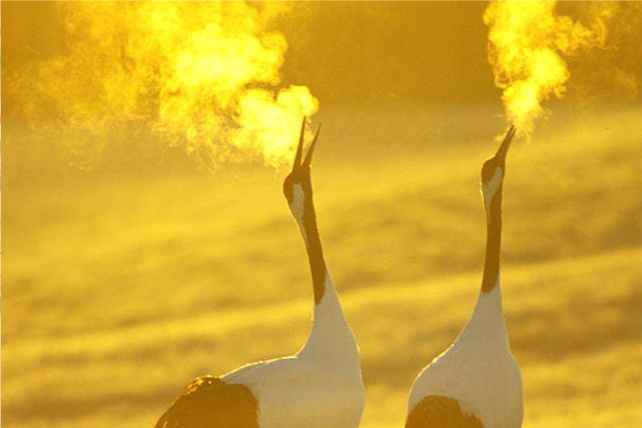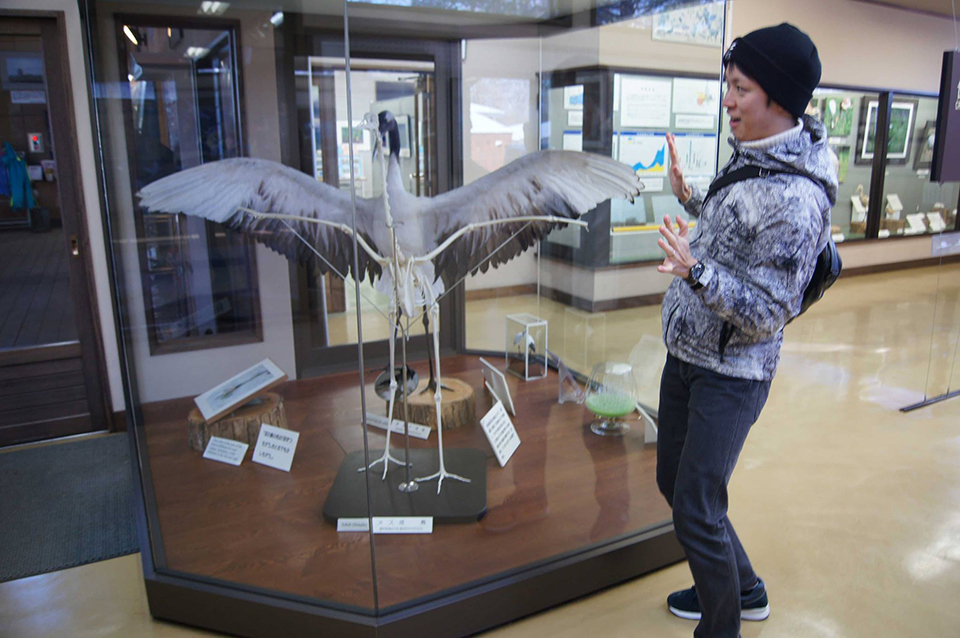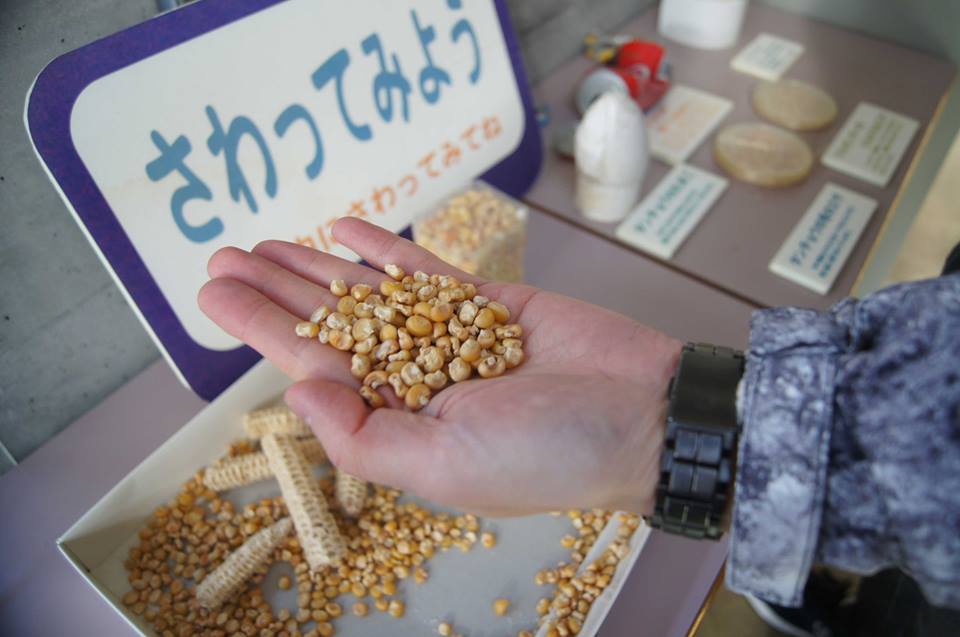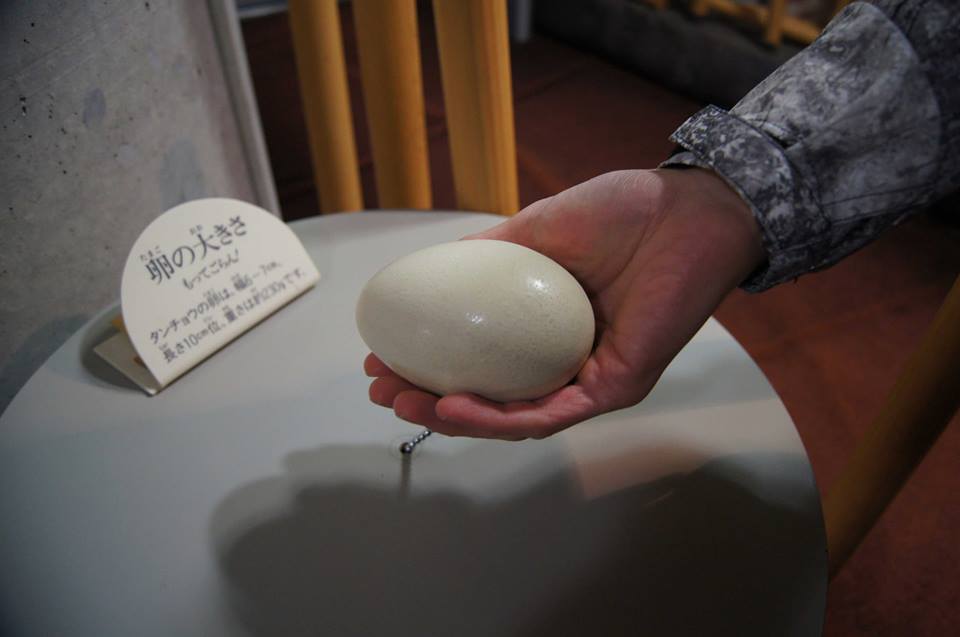Learning about the Tancho Crane
How can we tell if a tancho crane is male or female?
 It is difficult to tell if a tancho crane is male or female by appearance alone. However, we can determine a tancho crane’s gender by the calls that males and females use to communicate with each other. The male makes a “koh” call, to which the female responds with two calls: “ka-ka”. In the cold weather of winter, we can distinguish males and females from a distance by the plumes of white breath as they call to each other.
It is difficult to tell if a tancho crane is male or female by appearance alone. However, we can determine a tancho crane’s gender by the calls that males and females use to communicate with each other. The male makes a “koh” call, to which the female responds with two calls: “ka-ka”. In the cold weather of winter, we can distinguish males and females from a distance by the plumes of white breath as they call to each other.
The tancho crane’s beauty is more than skin deep! A bird of devoted love.
 Once a tancho crane has found a mate, it is said that they will stay together until one partner dies. There are stories of tancho cranes remaining next to their partners even after death, until the body finally fades from sight -- a testimony to the devoted love between these magnificent birds.
Once a tancho crane has found a mate, it is said that they will stay together until one partner dies. There are stories of tancho cranes remaining next to their partners even after death, until the body finally fades from sight -- a testimony to the devoted love between these magnificent birds.
In fact, at Tanchozuru Natural Park, a wild tancho crane flew into one of the cages, and became partners with one of the artificially-raised cranes. Since then, they can be seen lovingly raising their young every year. It seems that even the cage was no obstacle to this fateful meeting.
・Kushiro Japanese Crane Reserve:http://en.kushiro-lakeakan.com/things_to_do/3778/
Japan’s largest bird! You won’t believe its length!
 The tancho crane’s incredible size may not be apparent in photographs. Some tancho cranes have wingspans of about 240 cm, and lengths of around 140 cm.
The tancho crane’s incredible size may not be apparent in photographs. Some tancho cranes have wingspans of about 240 cm, and lengths of around 140 cm.
In the wild, tancho cranes are susceptible to accidents and injury, and they normally live to about 20 years of age. However, it is reported that in zoos or sanctuaries, tancho cranes may live more than 30 years.
In the Kushiro region, feeding is limited to the winter.
 As the snows of winter cover the wetlands, it becomes very difficult for tancho cranes to find food. In order to protect the tancho cranes, winter-only feeding stations are provided at several locations. A variety of corn, known as dent corn, is used as feed.
As the snows of winter cover the wetlands, it becomes very difficult for tancho cranes to find food. In order to protect the tancho cranes, winter-only feeding stations are provided at several locations. A variety of corn, known as dent corn, is used as feed.
In fact, when dent corn is harvested in autumn, tancho cranes can often be spotted in the corn fields, helping themselves to any remaining corn.
A year in the life of a tancho crane.
How do they spend their year?
 Snow begins to melt in late March, and as it becomes easier for tancho cranes to find food, they return to their own territories. At this time of year, they are seldom seen outside of the depths of the Kushiro Wetlands, and from April to June, tancho cranes with partners will lay eggs and begin to raise their young. Under the care of their parents, the newly-born tancho crane chicks grow swiftly, and begin to learn to fly in about 100 days. Then, in February to March, before the young tancho cranes are even a year old, they will be driven out of their parents’ territory. This process of parent-and-child parting marks the independence of the young tancho crane. At sanctuaries, you may notice that some tancho cranes have brown heads -- they are still young.
Snow begins to melt in late March, and as it becomes easier for tancho cranes to find food, they return to their own territories. At this time of year, they are seldom seen outside of the depths of the Kushiro Wetlands, and from April to June, tancho cranes with partners will lay eggs and begin to raise their young. Under the care of their parents, the newly-born tancho crane chicks grow swiftly, and begin to learn to fly in about 100 days. Then, in February to March, before the young tancho cranes are even a year old, they will be driven out of their parents’ territory. This process of parent-and-child parting marks the independence of the young tancho crane. At sanctuaries, you may notice that some tancho cranes have brown heads -- they are still young.
The tancho crane was once thought to have gone extinct!
 As wetlands diminished and tancho cranes were hunted by humans, the tancho crane population dwindled until they were thought to be extinct. However, towards the end of the Taisho Period (during the early to mid 1920s), around a dozen tancho cranes were discovered deep in the Kushiro Wetlands. Since then, local volunteers have helped to protect the tancho cranes through activities such as feeding, and as of 2014, there was a population of about 1500 tancho cranes living centered upon the Kushiro Wetlands. If it were not for the local people’s efforts to protect the tancho cranes, we may have lost these magnificent birds forever. We feel inspired to do our part to care for our natural environment, so that future generations may appreciate the beauty of the tancho cranes many years from now.
As wetlands diminished and tancho cranes were hunted by humans, the tancho crane population dwindled until they were thought to be extinct. However, towards the end of the Taisho Period (during the early to mid 1920s), around a dozen tancho cranes were discovered deep in the Kushiro Wetlands. Since then, local volunteers have helped to protect the tancho cranes through activities such as feeding, and as of 2014, there was a population of about 1500 tancho cranes living centered upon the Kushiro Wetlands. If it were not for the local people’s efforts to protect the tancho cranes, we may have lost these magnificent birds forever. We feel inspired to do our part to care for our natural environment, so that future generations may appreciate the beauty of the tancho cranes many years from now.
【Related Stories】
・The best place to view the tancho cranes, steward of the wetlands:http://en.kushiro-lakeakan.com/overview/3760/
・Kushiro and Lake Akan’s tancho cranes and marimo—one of a kind in the world:http://en.kushiro-lakeakan.com/things_to_do/6394/
・Winter time tancho crane photo tour *Guided tours recommended:http://en.kushiro-lakeakan.com/things_to_do/8199/
・Straight from the Tourist Association Staff!
7 pointers on to squeeze 120% more fun out of the Winter Tancho Crane bus.:http://en.kushiro-lakeakan.com/overview/10061/
Visitors who read this article also read:
-
Kushiro Lake Akan
In winter, tempts travelers with a variety of beautiful sights,…
10,981 views
-
Kushiro Lake Akan
Two National parks with differing ecosystems only found in Kush…
6,792 views
-
Kushiro Lake Akan
The 10 Best things to do in Kushiro and Lake Akan in autumn.
7,030 views
-
Kushiro Lake Akan
Various summer activities in the city, marshland, and Lake Akan
8,692 views
 Related Keywords
Related Keywords

